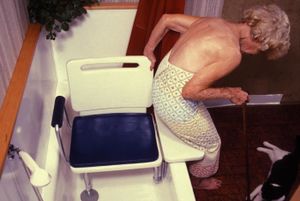Activities of Daily Living
Original Editor - Your name will be added here if you created the original content for this page.
Top Contributors - Lucinda hampton, Justin Bryan, Kim Jackson, Nikhil Benhur Abburi, Admin, Lauren Lopez, Tolulope Adeniji and Aminat Abolade
Activities of daily living (ADLs)[edit | edit source]
Activities of daily living (ADLs or ADL) is a term used in healthcare to refer to people's daily self care activities. Sidney Katz et al first came up with the term in the 1950s and the term has been revised since. Physiotherapists and other health professionals often use a person's ability or inability to perform ADLs as a measurement of their functional status, particularly in regard to people post injury, with disabilities and the elderly.[1]
A 2016 National Health Interview Survey in the USA found that 20.7% of adults 85 or older, 7% of those aged 75 to 84 and 3.4% of those aged 65 to 74 needed help with ADLs. Overall, 6.4% of adults aged more than 65 years needed help with personal care in 2016.[2]
A clear trend is emerging of increased care giving due to rapid growth in the number of older adults and because the faster growing cohort of older adults are those age 80 and older. More than half of 85- to 89-year-olds (59 percent) need caregiving because of health or functioning reasons. From age 90 on, only a minority of individuals (24 percent) do not need help from others. Dementia is a reason often for needing a family caregiver. In 2011 in the USA, 3.5 million of the 4.9 million older adults who received help for health or functioning reasons were classified as having probable dementia.[3]
Basic and Instrumental ADLs[edit | edit source]
Generally, older adults need to be able to manage ADLs and IADLs in order to live independently without the assistance of another person.
Basic ADLs- these are the basic self care tasks
Walking (ambulating) ability to get around the home or outside.
Feeding, ability to get food from a plate into one’s mouth.
Dressing and grooming ,ability to select clothes, putting them on, and adequately managing one’s personal appearance.
Toileting, ability to get to and from the toilet, using it appropriately, and cleaning oneself.
Bathing, ability to wash one’s face and body in the bath or shower.
Transferring, ability to move from one body position to another. This includes being able to move from a bed to a chair, or into a wheelchair. This can also include the ability to stand up from a bed or chair in order to grasp a walker or other assistive device.
Instrumental ADLs- require more complex thinking skills, including organizational skills.
Managing finances, such as paying bills and managing financial assets.
Managing transportation, either via driving or by organizing other means of transport.
Shopping and meal preparation. ie everything required to get a meal on the table. It also covers shopping for clothing and other items required for daily life.
Housecleaning and home maintenance. Cleaning kitchens after eating, maintaining living areas reasonably clean and tidy, and keeping up with home maintenance.
Managing communication, eg telephone and mail.
Managing medications, ie obtaining medications and taking them as directed.[5]
Physiotherapy[edit | edit source]
Physiotherapists assess ADLs and IADLs as part of assessing an older person’s “function.” Problems with ADLs and IADLs usually reflect problems with physical health and/or cognitive health. Identifying functional difficulties can help us diagnose and manage problems affecting their everyday life.
Physiotherapists help people perform ADLs through exercise therapy and improving strength and joint mobility. Improving gait speed, grip strength, pain reduction, improved balance etc all improve a persons ability to perform ADLs. Help is also achieved through advice and teaching of use of assistive devices eg 4 wheel walkers, joint orthoses.
Resources[edit | edit source]
- bulleted list
- x
or
- numbered list
- x
References[edit | edit source]
- ↑ Wikipedia. Activities of daily living. Available from: https://en.wikipedia.org/wiki/Activities_of_daily_living (last accessed 6.5.2019)
- ↑ McKnights Senior Living. Dec. 20 2017. CDC: More than 20% of 85+ adults need ADL assistance Available from: https://www.mcknightsseniorliving.com/home/news/cdc-more-than-20-of-85-adults-need-adl-assistance/ (last accessed 6.5.2019)
- ↑ Committee on Family Caregiving for Older Adults; Board on Health Care Services; Health and Medicine Division; National Academies of Sciences, Engineering, and Medicine; Schulz R, Eden J, editors. Families Caring for an Aging America. Washington (DC): National Academies Press (US); 2016 Nov 8. 2, Older Adults Who Need Caregiving and the Family Caregivers Who Help Them. Available from: https://www.ncbi.nlm.nih.gov/books/NBK396397/ (last accessed 6.5.2019)
- ↑ Audiopedia ADL. Available from: https://www.youtube.com/watch?v=7C0FFUG0Bk4 (last accessed 6.5.2019)
- ↑ Better health while aging. What are Activities of Daily Living (ADLs) & Instrumental Activities of Daily Living (IADLs)? Available from: https://betterhealthwhileaging.net/what-are-adls-and-iadls/ (last accessed 6.5.2019)







